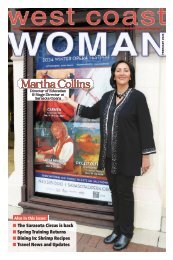wcw AUGUST 2023
Our August issue has a profile with Sarasota artist Linda Richichi. Features include a look at the Little Art Gallery’s new home, Good News Dept., Calendars, Blobfest, You're News, Travel News, Women’s Equality day and the Importance of staying hydrated. Plus, take a visit to the US Botanic Garden in DC.
Our August issue has a profile with Sarasota artist Linda Richichi. Features include a look at the Little Art Gallery’s new home, Good News Dept., Calendars, Blobfest, You're News, Travel News, Women’s Equality day and the Importance of staying hydrated. Plus, take a visit to the US Botanic Garden in DC.
Create successful ePaper yourself
Turn your PDF publications into a flip-book with our unique Google optimized e-Paper software.
travel<br />
Check out the<br />
US Botanic Garden, Washington, DC<br />
Oasis of beauty and serenity in the nation’s capitol<br />
IF<br />
I worked in Washington, DC,<br />
I would have my lunch outside<br />
at the US Botanic Garden.<br />
I’d also go inside and surround<br />
myself with tropical moisture on<br />
a cold winter’s day. And if a lot was weighing<br />
on my mind, I’d pop in and walk among<br />
the orchids. You get the idea. Tropical<br />
gardens, conservatories, and the like, are<br />
peaceful retreats that are also invigorating<br />
and refreshing.<br />
The US Botanic Garden is unique in that<br />
it sits on the National Mall - that dense<br />
space where US history and its many<br />
treasures are on display in a variety of<br />
museums and national monuments as well<br />
as our working government. The Garden,<br />
located next to the Capitol Reflecting Pool,<br />
was on the wish lists of George Washington,<br />
Thomas Jefferson and James Madison<br />
who all wanted a national botanic garden<br />
for the young nation’s capitol.<br />
Thus the history of the U.S. Botanic<br />
Garden coincides with the history of the<br />
U.S. itself, and, with their efforts as well as<br />
others, one was established on the National<br />
Mall in 1820. According to their website,<br />
The Botanic Garden has been in continuous<br />
operation since 1850 and in its current<br />
location since 1933.<br />
The Garden is a living plant museum<br />
that shows the importance of plants to<br />
not just human beings, but the earth’s<br />
ecosystems as a whole. It offers a historic<br />
conservatory that houses courtyard gardens,<br />
themed garden rooms, and special<br />
exhibits.<br />
The Garden extends to its outside<br />
grounds where there are plantings that<br />
represent different environments from<br />
around the United States. Across the road<br />
from the conservatory, Bartholdi Park is a<br />
showcase for plant combinations centered<br />
around a beautiful fountain.<br />
Exactly what is a botanic garden? Today,<br />
cultivation and preservation, as well as<br />
botanical displays and carefully-selected<br />
plant collections is what sets a botanic garden<br />
apart. The International Association<br />
of Botanic Gardens decided in 1963 that a<br />
botanic garden is a place ‘open to the public<br />
in which the plants are labelled.’<br />
All modern botanic gardens have a role<br />
in plant science, conservation and inspiring<br />
the public to appreciate the vital role<br />
of plants and fungi to life on Earth. Today,<br />
there are 1,775 botanic gardens in 148<br />
countries world-wide so that explains in<br />
part why they are so popular.<br />
The “wow” factor is how lush the interiors<br />
of the Garden’s buildings are. You<br />
can climb metal stairs and walk among<br />
the sub-tropical and tropical plants from<br />
around the world and get misted and feel<br />
transported. It’s also a “wow” to see such<br />
diversity in nature and come face-to-face<br />
with plants that give us many products that<br />
are vital in health, but also for enjoyment<br />
(like chocolate).<br />
7<br />
Latest exhibit:<br />
The United States Botanic Garden has an<br />
exhibit sharing the stories of agriculture –<br />
from the people that grow the food and the<br />
important cultural connections food provides<br />
to modern techniques and scientific<br />
innovations that make agriculture more<br />
sustainable and productive. “Cultivate:<br />
Growing Food in a Changing World” is on<br />
display through December <strong>2023</strong>.<br />
Visitors can learn how inventive ideas<br />
in agriculture, both scientific and social,<br />
sustain and enrich life and how growing<br />
and cooking food connects people with<br />
each other and their communities. You<br />
can see dozens of colorful varieties of<br />
corn and learn about the wild relatives<br />
of modern plants we eat, go hands-on to<br />
explore the science of agriculture through<br />
microscopes and hand lenses, dive into the<br />
stories of the many different peoples that<br />
have farmed the land through the centuries,<br />
and enjoy the smells of the plants that<br />
connect several local chefs with their food<br />
cultures.<br />
Find upcoming programs at www.<br />
USBG.gov.<br />
7<br />
History:<br />
The United States Botanic Garden is the<br />
oldest continuously operating public<br />
garden in the United States. The Garden<br />
is rooted in the nation’s heritage. During<br />
the late 18th century, George Washington<br />
had a dream of a national botanic garden<br />
and was instrumental in establishing one<br />
on the National Mall in 1820. Washington's<br />
letter written in support of a botanic<br />
garden in the new federal city is in the archives<br />
of the Library of Congress.<br />
The institution traces its beginning to<br />
1816, when the constitution of the Columbian<br />
Institute for the Promotion of Arts<br />
and Sciences in Washington, D.C., proposed<br />
the creation of a botanic garden to<br />
collect, grow and distribute plants of this<br />
and other countries that might contribute<br />
to the welfare of the American people.<br />
On May 8, 1820, President James Madison<br />
signed a bill passed by the U.S. Congress<br />
designating land for the garden to<br />
the west of the Capitol Grounds, from First<br />
Street to Third Street between Pennsylvania<br />
and Maryland Avenues.<br />
This facility functioned until 1837, shortly<br />
after the organization stopped holding<br />
meetings. In 1842, the idea of a national<br />
botanic garden was reestablished when<br />
the United States Exploring Expedition<br />
to the South Seas (the Wilkes Expedition)<br />
brought a collection of living plants from<br />
around the globe to Washington, D.C.<br />
These formed the first permanent collection<br />
of plants for the U.S. Botanic Garden,<br />
and four plants in the Garden today date<br />
back to this expedition. The plants were<br />
kept in a specially constructed greenhouse<br />
behind the Old Patent Office Building<br />
while a new Conservatory for the Garden<br />
was constructed between 1842-1850.<br />
The Victorian Conservatory opened to<br />
the public in 1850 and the U.S. Botanic<br />
Garden has been in continuous operation<br />
and open to the public since this date.<br />
The Garden moved to its present location<br />
in 1933 and includes the Conservatory,<br />
which was renovated from 1997-2001;<br />
the gated outdoor gardens, which opened<br />
in 2006; and Bartholdi Fountain and Gardens,<br />
which were created in 1932.<br />
The U.S. Botanic Garden maintains more<br />
than 9,500 accessions, which equates to<br />
about 44,000 plants. These are used for<br />
exhibition, study, and exchange with other<br />
institutions. The Garden's noteworthy<br />
collections include economic plants, medicinal<br />
plants, orchids, carnivorous plants,<br />
cacti and other succulents, aroids, plants<br />
of eastern North America, bromeliads, cycads,<br />
and ferns.<br />
7<br />
Visiting the U.S. Botanic Garden<br />
Learn about the importance and fundamental<br />
value and diversity of plants, as<br />
well as their aesthetic, cultural, economic,<br />
therapeutic, and ecological significance.<br />
There’s excellent public transportation in<br />
the area since it’s just off the Mall. Try to<br />
Metro - it’s clean, affordable and easy to<br />
navigate.<br />
H Location: 100 Maryland Avenue SW,<br />
Washington, DC<br />
H Hours: open every day of the year<br />
from 10 a.m. – 5 p.m., with the National<br />
Garden staying open until 7 p.m. from<br />
Memorial Day until Labor Day. Bartholdi<br />
Park is open every day from dawn until<br />
dusk<br />
H Admission: Free<br />
H More info: www.USBG.gov<br />
H Virtual 360 degree tour: www.google.<br />
com/maps<br />
20 WEST COAST WOMAN <strong>AUGUST</strong> <strong>2023</strong>
















